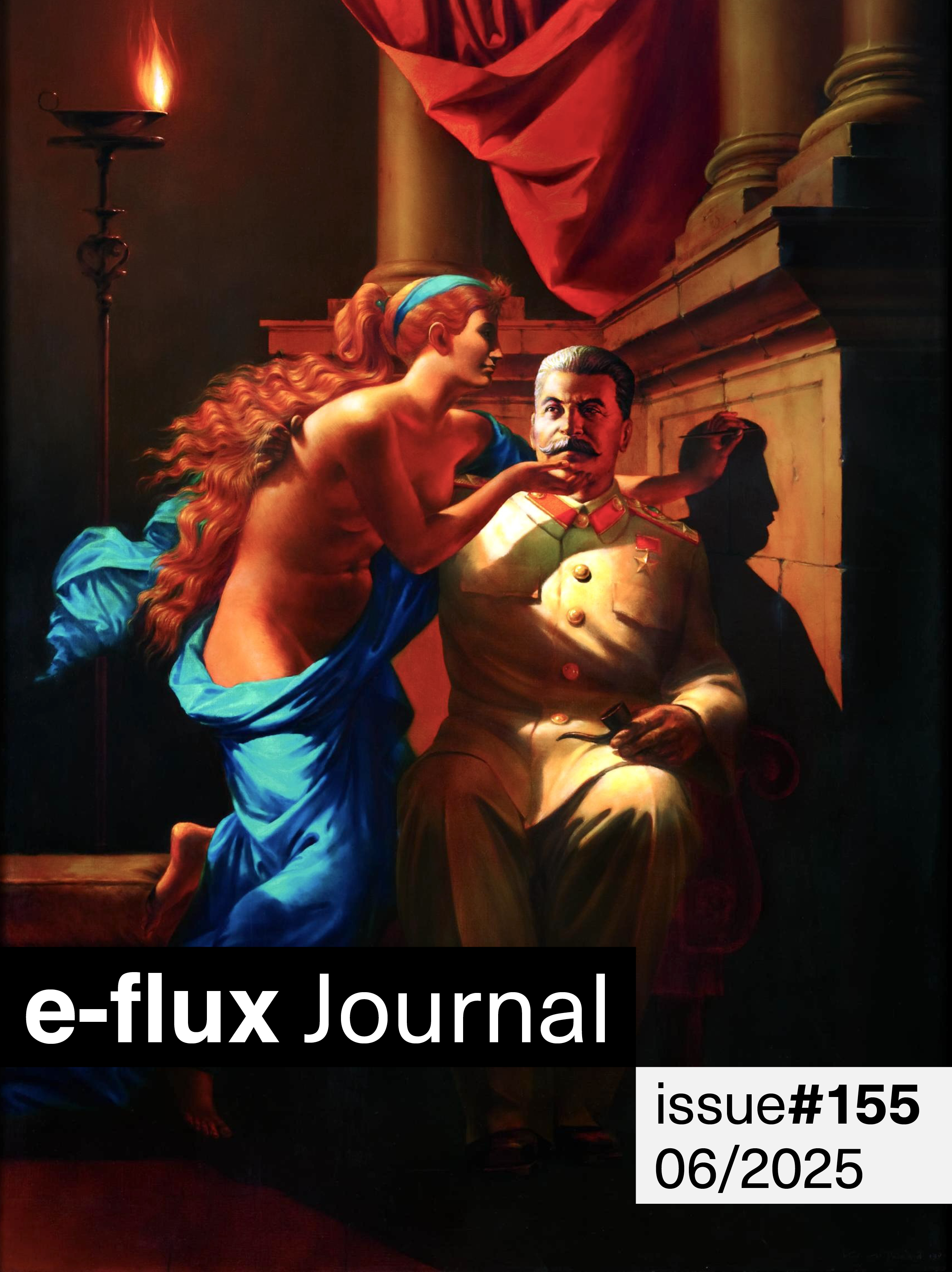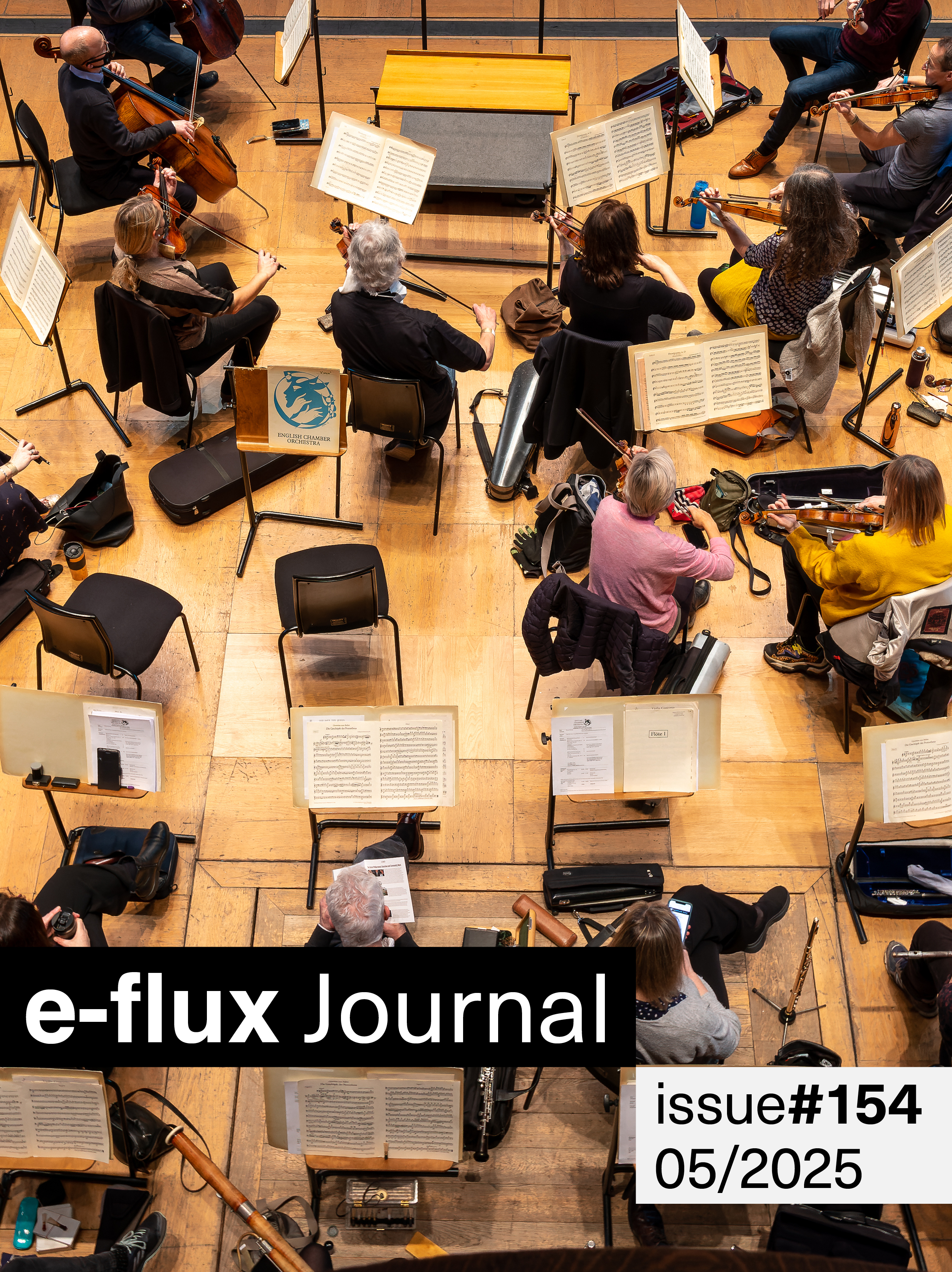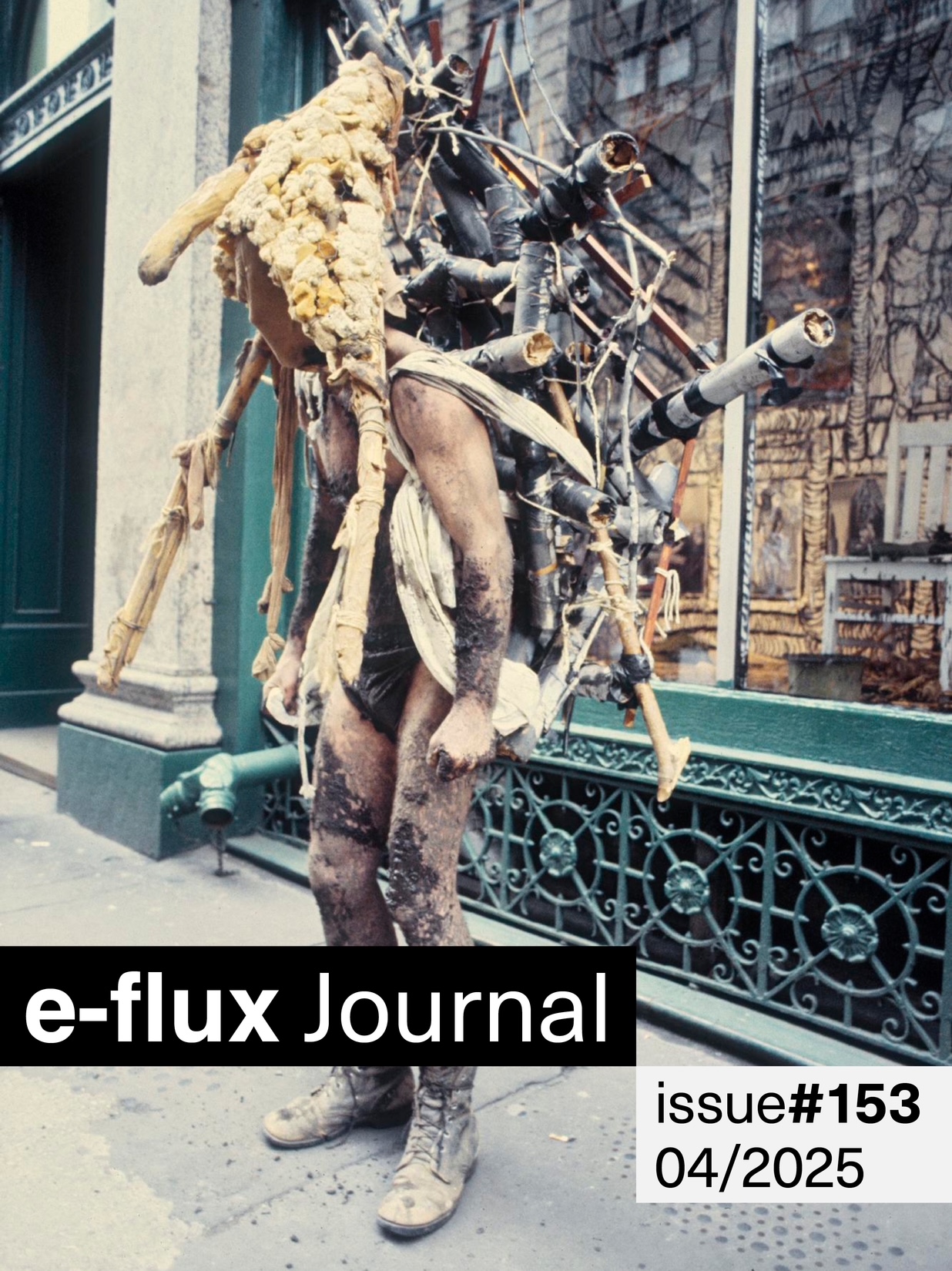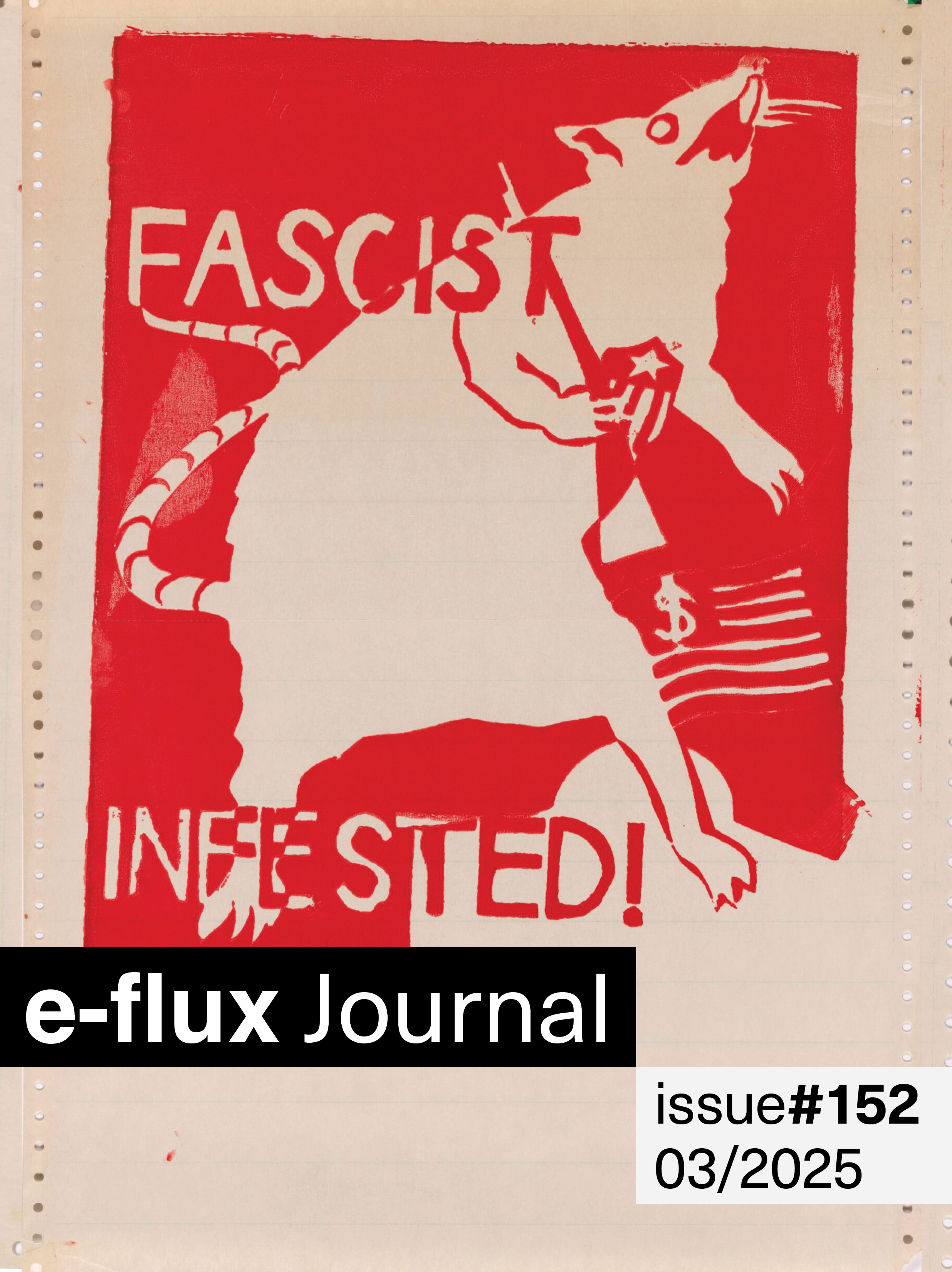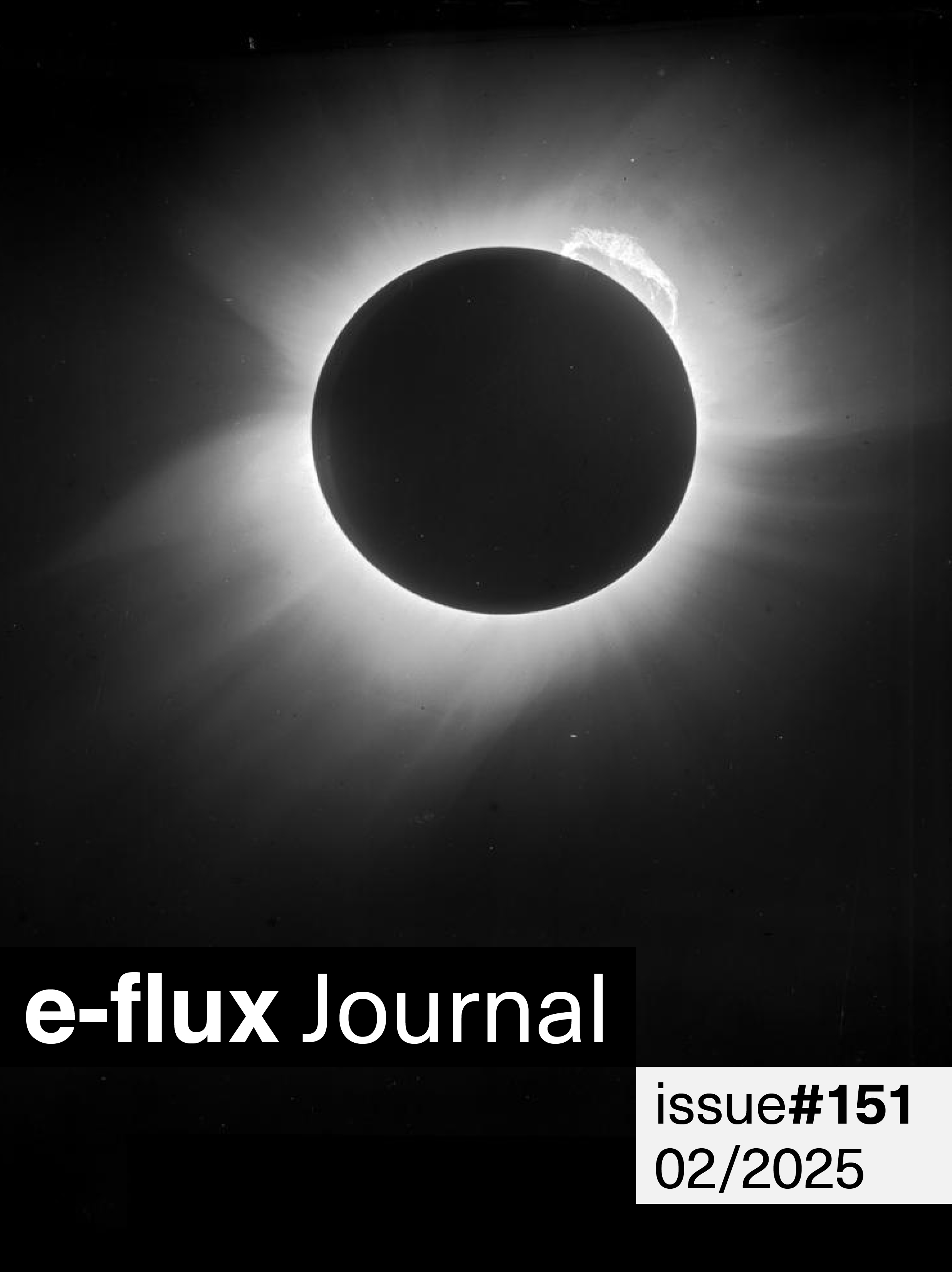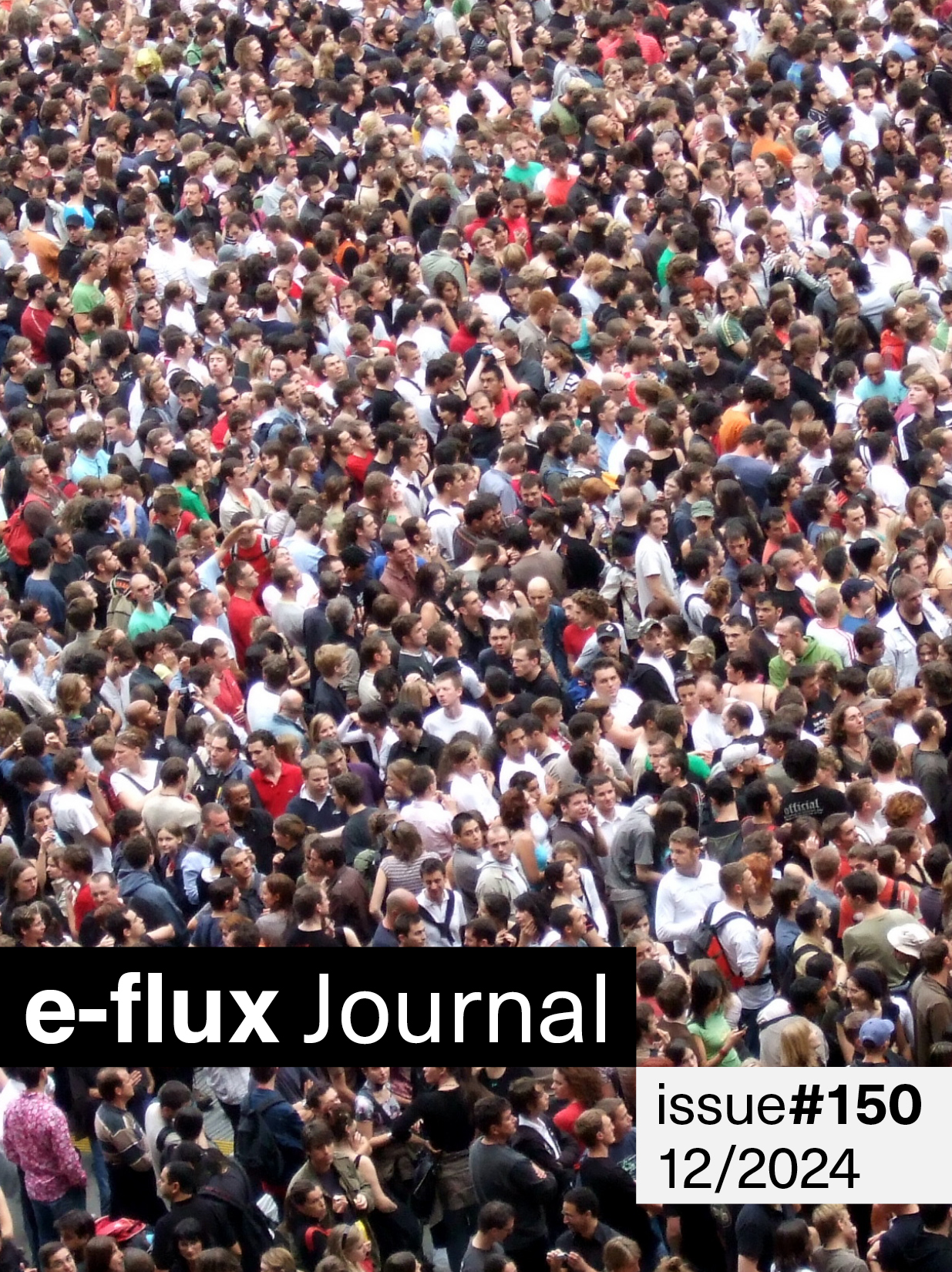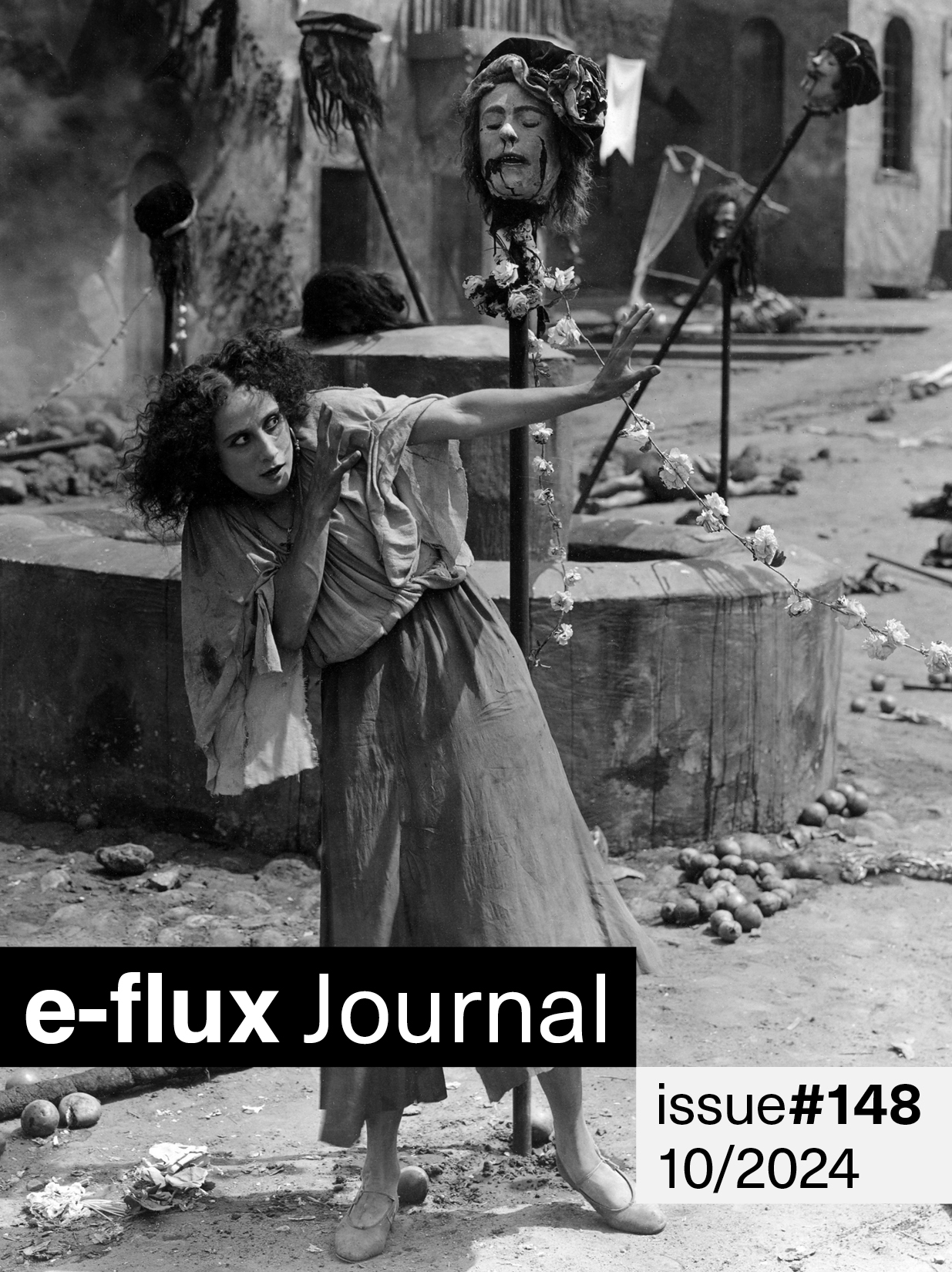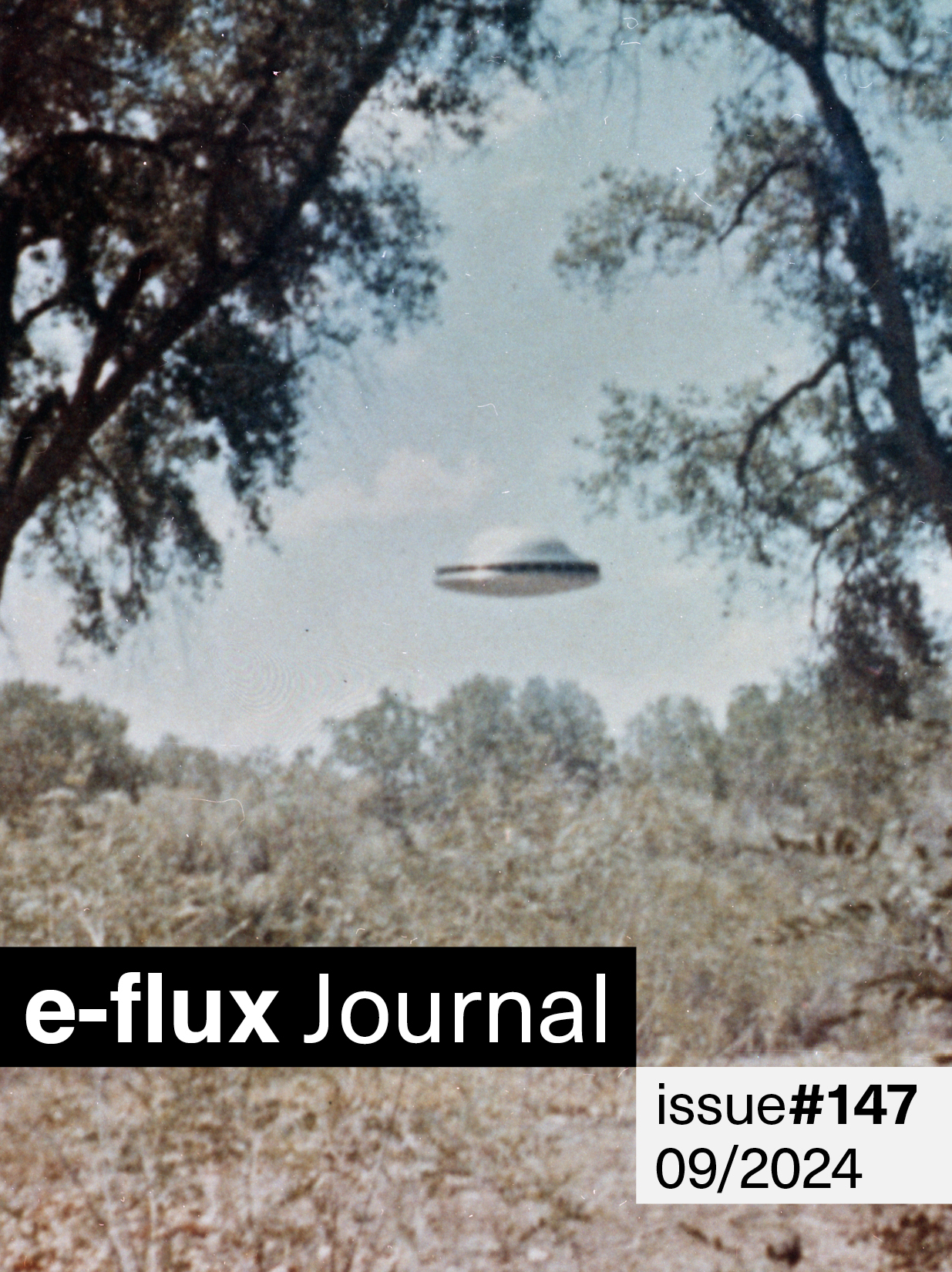e-flux journal summer 2012 issue ANIMISM
guest-edited by Anselm Franke
Outdoor screening of works by Ken Jacobs,
Antje Majewski, and Jean Painlevé,
with an introduction by Ken Jacobs
July 19, 8:30pm
at Abrons Arts Center
466 Grand Street, New York
read more
Animism closing event:
“The Vanishing Point of the Modern”
with Anselm Franke, Tom Keenan,
Spyros Papapetros, and Elizabeth Povinelli
July 26, 6:30pm at e-flux
311 East Broadway, New York
read more
www.e-flux.com/issues/36-july-2012
For the Summer 2012 issue of e-flux journal we are very pleased to present a special “Animism” issue guest-edited by Anselm Franke, curator of the exhibition by the same name. Even if you missed Animism on tour in Europe since it began at Extra City and MUHKA in Antwerp in 2010, you have probably learned of its encompassing mobilization of the systems of inclusion and exclusion defining “science” and “culture.” The various stages of the exhibition have shown the discourse of animism to be a crucial skeleton key for releasing the deadlocks formed by the repressed religious, teleological, and colonial foundations of modernity—the hysteria within its narrative that continues to shape the exhibition formats and sensibilities we are tethered to. The fifth iteration of Animism is now on view at e-flux in New York until July 28.
—Julieta Aranda, Brian Kuan Wood, Anton Vidokle
A ghost is haunting modernity—the ghost of animism. It awaits us everywhere when we step outside modern reason’s cone of light, outside its firmly mapped order, when approaching its frontier zones and “outside.” We find it in the imagined darkness of modernity’s outside, where everything changes shape and the world is reassembled from the fragments that reason expels from its chains of coherences.
The task is to bring those constitutive others at the “dark” side of modern reason—like “animism,” but also the “imaginary,” the “negative,” “otherness,” or even “evil”—back into the relational diagram of modernity. To take those universalized sites of otherness that receive names such as “a universal tendency of humankind” or even its “origin,” and bring them back into history, would be perhaps the only way to account for the relational constitution of the present, to face the sorcery of its double binds. To embark upon this task is thus to understand these are never given “universals” of the modern, but its very relational products. They are the sites that modern history is silent about, to the extent that the very narrative of the “the modern” is built upon this silence as its fundament. The narrative-imaginary vacuum of the present is the direct outcome of this silence. This silence tells us that it is actually not animism, but modernity that is the ghost—halfway between presence and absence, life and death. And the future grand narratives of modernity may well speak of this ghost from the perspective of its other, from its “animist” side.
We see signs of this happening already, for it is now clear that the modern arrow of time has changed directions. The future is no longer a white sheet of paper awaiting our projective prescriptive schemes and designs, and the past is no longer the archaic animist “stage” of multiple contagions and mediations which must be surmounted as “entry” condition into the hygienic order of modernity. The future is now behind us, and the past approaches us from the front. The specter of animism is no longer one that returns from the past, for the reversal of modern temporality has announced itself for some time in the ability to challenge monolithic modernist narratives with a multitude of other modernities that ultimately expose and highlight those contagions, hybridities, and mobilities that oppose the foundational modern acts of separation, inscription, and fixation. Here, animism shifts to become the experience of the event and experience that sets in when a naturalized, fixed order of signs is de-stabilized and opened up towards possible transformation, like a map covering the territory that is lifted to unveil multiple movements below what had appeared to be stable ground. Animism is thus no longer historical but is rather the ground upon which history is placed.
Today it is no longer the reified script modernity that we are enacting, but that of the “self.” No longer unrestrictedly exporting its discontents into an imaginary primitive outside and other dumping grounds, the new site of export and displacement of social conflicts is interiority at the frontier of subjectivity. It is at this frontier where the double bind of imposed choice and the deadlock on the imaginary currently hits, as a conflation of difference between system and subject whence the subject must keep this difference up.
—Anselm Franke
In this issue:
Isabelle Stengers—Reclaiming Animism
Scientists may disagree on how we are wrong, but they agree that we are wrong. The epic is no longer about the “ascent of Man,” but rather about the ascent of the Scientist. How, then, to keep the question of animism, if it is taken seriously at all, from being framed in terms that verify Science’s right to define it as an object of knowledge?
Harry Garuba—On Animism, Modernity/Colonialism, and the African Order of Knowledge: Provisional Reflections
This means that all of these other histories, written within the protocols and idioms of the modern and the disciplinary practices that emerged from the modern episteme, were only Kenyan or Indian or Chinese in data, not in their authorizing discursive form. I read this as further saying that the paradigms and protocols of the discourse of academic history do not provide a discursive space from which to write a “non-modern” history, if you like—a history that does not inscribe the modernist, linear conception of time.
Spyros Papapetros—Darwin’s Dog and the Parasol: Cultural Reactions to Animism
It is as if the dog’s growl crossed a line between different topographies: animal and human, “savage” and civilized, textual and real. Darwin himself attempts to anthropomorphize his dog: “full grown and very sensible” as well as capable of rationalizing the agency of movement. The dog, in turn, momentarily animalizes Darwin’s mind, causing his thoughts to swerve and forcing him to identify reason as, essentially, an animal defense.
Diedrich Diederichsen—Animation, De-reification, and the New Charm of the Inanimate
There is an old educational idea of confronting animals and anthropomorphic candidates for animation with a hostile technological world of hard matter—one that we need tools to come to grips with because songs and kind words won’t do—and this idea no longer works. The pseudo-de-instrumentalized reason of the post-Fordist and post-industrial condition is meant to train “soft skills” and human-resources leadership techniques, but it doesn’t always work out. On occasion, this attitude will fall into its other—into love.
Michael Taussig—The Stories Things Tell And Why They Tell Them
Let us pause for a moment and note the chronology of cause and effect here. It is the sailors who tell each other stories—stories about the ship or stimulated by the ship—and then the ship itself comes alive, hoards the stories, retells them, and makes up its own stories, which are presumably compounds of the stories of countless sailors told over millennia. It is thus storytelling that animates the ship and keeps it going—storytelling and the coal the stokers shovel into the furnaces.
Anselm Franke—Animism: Notes on an Exhibition
In this process, outer reality comes to be defined in terms of an objectified nature—that is, as a nature uncontaminated by social representations, symbolizations, and projections. But if the holy task of modern knowledge was to calculate away from the outer world that which humans had previously projected onto it (thus initiating the Cartesian legacy), then where did the contents of such projections go?
Angela Melitopoulos and Maurizio Lazzarato—Assemblages: Félix Guattari and Machinic Animism
This is animism: the idea that the basis of the real is the soul. It’s not an immaterial soul, or a soul that is in opposition to matter. On the contrary, it is matter itself that is steeped in soul. In the end, that is what animism is about. It’s the idea that the subject is not a private or exclusive property of humans, but is rather the base of the real.
Rane Willerslev—Laughing at the Spirits in North Siberia: Is Animism Being Taken too Seriously?
While the elderly hunter was poking out its eyes with his knife and croaking like a raven as custom prescribes, the younger one, who was standing a few meters away, shouted to the bear: “Grandfather, don’t be fooled, it is a man, Vasili Afanasivich, who killed you and is now blinding you!” At first the elderly hunter doing the butchering stood stock-still as if he were in shock, but then he looked at his younger partner and they both began laughing ecstatically as if the whole ritual were a big joke.
Alejandro Haber—Severo’s Severity and Antolín’s Paradox
Severo knew quite well what I was thinking about the archaeological site, what my ontological assumptions were, what I was looking for, and what kind of praxis I would develop with respect to the antiguos. That is why he came to intervene before I started my excavation; he placed my relationship to the antiguos within the terms of the local theory of relatedness, and through our involvement in a ritual conversation with the antiguo he implicitly explained to my students and me what kind of relations they—antiguos—expected from us.
Cornelius Borck—Animism in the Sciences Then and Now
Today’s technosciences constitute ever more entities with agency in relation to biological, individual, subjective, collective, or political levels of being. In this context, animism may demonstrate an unexpected potential as a conceptual tool for highlighting and describing precisely those deviations from modern epistemology that pass under its own guidance.
Tom Holert—”A live monster that is fruitful and multiplies”: Capitalism as Poisoned Rat?
It may be a critical (de)constructivist commonplace to emphasize the discursive processes that lead to the “naturalization” of capital. However, it is worth mentioning that even if one critiques capitalism as a “‘system’ that profits by its reproduction” (Judith Butler), this way of speaking still tends to naturalize, even anthropomorphize, capitalism—of which one could say, it is precisely a “humanism” that uses humanity as an abstraction to propagate “the sphere of commodity exchange [as] a true Eden of innate human rights,” as Karl Marx put it.
The print edition of e-flux journal can now be found at:
Amsterdam: De Appel / Rijksakademie van beeldende kunsten Andratx: CCA Andratx Antwerp: M HKA Museum van Hedendaagse Kunst Athens: OMMU Auckland: split/fountain Austin: Arthouse at the Jones Center Baden-Baden: Staatliche Kunsthalle Baden-Baden Belgrade: Cultural Centre of Belgrade Banff: Walter Phillips Gallery, The Banff Centre Barcelona: Arts Santa Monica / MACBA Basel: Kunsthalle Basel, Museum fur Gegenwartskunst Beijing and Guangzhou: Vitamin Creative Space Beirut: 98weeks Belgrade: Cultural Center of Belgrade Bergen: Bergen Kunsthall / Rakett Berlin: b_books / Berliner Künstlerprogramm – DAAD / do you read me? / NBK, Neuer Berliner Kunstverein / Pro qm Berlin and Zurich: Motto Bern: Kunsthalle Bern Bialystok: Arsenal Gallery Bielefeld: Bielefelder Kunstverein Birmingham: Eastside Projects / Ikon Gallery Bologna: MAMbo – Museo d’Arte Moderna di Bologna Bregenz: Kunsthaus Bregenz Bristol: Arnolfini Brussels: Wiels Bucharest: National Museum of Contemporary Art Bucharest (MNAC) / Pavilion Unicredit Cairo: Contemporary Image Collective (CIC) / Townhouse Gallery Calgary: The New Gallery Cambridge: Wysing Arts Center Castello: Espai d´art contemporani de Castelló (EACC) Chicago: Graham Foundation / The Renaissance Society Cologne: Kölnischer Kunstverein Copenhagen: Overgaden Derry: CCA Derry~Londonderry Dubai: Traffic Dublin: Dublin City, The Hugh Lane / Project Arts Centre Dusseldorf: Kunstverein für die Rheinlande und Westfalen Eindhoven: Van Abbemuseum Farsta: Konsthall C Frankfurt: Städelschule / Portikus Gdansk: Centrum Sztuki Współczesnej Łaźnia Ghent: S.M.A.K Glasgow: CCA Centre for Contemporary Arts / Sculpture Studios Graz: Grazer Kunstverein / Kunsthaus Graz / para_SITE Gallery Grijon: LABoral Centre for Art and Creative Industries Hamburg: Kunstverein Helsinki: Museum of Contemporary Art KIASMA Hobart: CAST Gallery / INFLIGHT Hong Kong: Asia Art Archive Istanbul: BAS / CDA – Projects / DEPO / SALT Innsbruck: Galerie im Taxispalais Johannesburg: Center for Historical Reenactments Kristiansand: SKMU Sørlandet Art Museum Kansas City: La Cucaracha PressKlagenfurt: Press Kunstraum Lakeside Leeds: Pavilion Lisbon: Maumaus, Escola de Artes Visuais / Oporto Loughborough: Radar, Loughborough University Ljubljana: Moderna Galerija LLandudno: Mostyn London: Architectural Association/Bedford Press / Gasworks / ICA / Serpentine Gallery/ The Showroom / Visiting Arts Los Angeles: REDCAT Luxembourg: Casino Luxembourg Madrid: Brumaria / CA2M / Pensart Maastricht: Jan van Eyck Academie Marfa: Ballroom Marfa Melbourne: Monash University Museum of Art / World Food Books Mexico City: Proyectos Monclova Milan: Fondazione Nicola Trussardi, Hangar Bicocca, Milton Keynes: Milton Keynes Gallery Minneapolis: Walker Arts Center Moncton: Fixed Cog Hero (a bicycle courier company) Montreal: Canadian Centre for Architecture Moscow: Garage Center for Contemporary Culture Munich: Museum Villa Stuck / Walther Koenig Bookshop, Haus der Kunst Munich New Delhi: Sarai CSDS New York: e-flux / Independent Curators International (ICI) / Printed Matter, Inc Nottingham: Nottingham Contemporary Omaha: Bemis Center for Contemporary Arts Oslo: Kunstnernes hus Oxford: Modern Art Oxford Padona: Fondazione March Paris: castillo/corrales – Section 7 Books / Centre Pompidou / Les Laboratoires d’Aubervilliers Philadelphia: Bodega Pori: Pori Art Museum Porto: Museu de Arte Contemporânea de Serralves Portland: Portland Institute for Contemporary Art, (PICA) / Publication Studio Prague: Dox Centre for Contemporary Art Prishtina: Stacion – Center for Contemporary Art Prishtina Providence: AS220 Reykjavik: Reykjavik Art Museum Riga: Kim? Rio de Janeiro: Capacete / A Gentil CariocaRome: MACRO Museo d’Arte Contemporanea Roma / Opera Rebis Rotterdam: Piet Zwart Institute / Witte de With Saint-Nazaire: Le Grand Cafe, Centre D’art Contemporain Salzburg: Salzburger Kunstverein San Antonio: Artpace São Paulo: Master in Visual Arts, Faculdade Santa Marcelina Sarajevo: Sarajevo Center for Contemporary Art Seoul: The Books / The Book Society Sherbrooke: Foreman Art Gallery of Bishop’s University Skopje: Press to Exit Project Space Sofia: ICA Sofia / Sofia Art Gallery St Erme Outre et Ramecourt: Performing Arts Forum St Louis: White Flag Projects Stockholm: Bonniers Konsthall / IASPIS / Index / Konstfack, University College of Art, Craft and Design Stuttgart: Württembergischer Kunstverein Stuttgart Sydney: Artspace Tallinn: Kumu Art Museum of Estonia The Hague: Stroom Den Haag Toronto: Mercer Union / The Power Plant Torun: Centre of Contemporary Art Znaki Czasu in Torun Umeå: Bildmuseet, Umeå University Utrecht: BAK, basis voor actuele kunst / Casco-Office for Art, Design and Theory Vaduz: Kunstmuseum Liechtenstein Valletta: Malta Contemporary Art Foundation Vancouver: ARTSPEAK / Morris and Helen Belkin Art Gallery, University of British Columbia / Fillip / Motto / READ Books, Charles H. Scott Gallery, Emily Carr University of Art and Design Vienna: Salon für Kunstbuch, Belvedere GalleryVigo: MARCO, Museo de Arte Contemporanea de Vigo Vilnius: Contemporary Art Centre (CAC) Vitoria-Gasteiz: Montehermoso Kulturunea Visby: BAC, Baltic Art Center Warsaw: Zachęta Narodowa Galeria Sztuki / Zachęta National Gallery of Art Wiesbaden: Nassauischer Kunstverein (NKV) Yerevan: Armenian Center For Contemporary Experimental Art, NPAK Zagreb: Galerija Miroslav Kraljevic / Gallery Nova / Institute for Duration, Location and Variables, DeLVe Zurich: Postgraduate Program in Curating, Zürich University of the Arts / Shedhalle / White Space.
